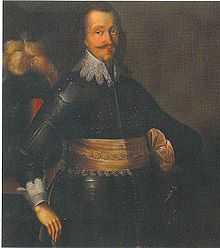Johann Philipp, Duke of Saxe-Altenburg
| Johann Philipp | |
|---|---|
 | |
| Duke of Saxe-Altenburg | |
| Reign | 1603–1639 |
| Predecessor | Johann |
| Successor | Friedrich Wilhelm II |
| Spouse | Elisabeth of Brunswick-Wolfenbüttel |
| Issue | Elisabeth Sophie, Duchess of Saxe-Gotha-Altenburg |
| House | House of Wettin |
| Father | Friedrich Wilhelm I, Duke of Saxe-Weimar |
| Mother | Anna Maria of the Palatinate-Neuburg |
| Born |
25 January 1597 Torgau |
| Died |
1 April 1639 (aged 42) Altenburg |
| Religion | Lutheranism |
Johann Philipp (Torgau, 25 January 1597 – Altenburg, 1 April 1639), was a duke of Saxe-Altenburg.
He was the eldest (but fourth in order of birth) surviving son of Friedrich Wilhelm I, Duke of Saxe-Weimar and Anna Maria of the Palatinate-Neuburg, his second wife.
Childhood
When his father died (1602), Johann Philipp and his younger brothers Frederick, Johann Wilhelm and Friedrich Wilhelm were underage. Because of this, his uncle Johann (more interested in natural sciences and art than politics) took over his guardianship and the regency of his inheritance; but shortly after he took all the duchy of Saxe-Weimar into his own hands.
The next year (1603), the young prince of Saxe-Weimar demanded his own inheritance, but his uncle Johann opposed this. But finally, both parts made a divisionary treaty of the family lands: Johann Philipp and his brothers took Altenburg and some towns, and Johann retained Weimar and Jena.
Because they were still underage, the regency of his duchy was taken by Christian II, Elector of Saxony (1603–1611) and later by his brother and next Elector, John George I (1611–1618).
Adulthood
In 1618, Johann Philipp, as elder son, was declared adult and assumed the government of the duchy of Saxe-Altenburg. Also, he took over the guardianship of his younger siblings. The four brothers co-ruled the duchy, but two of them died soon after and childless: Frederick, who was killed in action in 1625, and Johann Wilhelm, died in Brieg on 1632.
Johann Philipp and his only surviving brother, Friedrich Wilhelm II, continued as co-rulers; but, in fact, it was Johann Philipp who really assumed the supreme and full control of the government until his death.
In 1613, Johann Philipp was appointed Dean of the University of Leipzig. Also, he was an active member of the Fruitbearing Society.
In 1638, he received the towns of Coburg, Bad Rodach, Römhild, Hildburghausen and Neustadt, according to the divisionary treaty between him and the branch of Saxe-Weimar after the death of the duke John Ernest of Saxe-Eisenach without surviving issue.
Before his death, he made a will, when he declared his daughter the general heiress of the branch of Saxe-Altenburg, only in case of extinction of the male issue of the family. This will later originated a dispute between the branches of Saxe-Gotha and Saxe-Weimar.
Johann Philipp was succeeded by his younger and only surviving brother, Frederick William II.
Ancestry
Marriage and issue
In Altenburg on 25 October 1618 Johann Philipp married Elisabeth of Brunswick-Wolfenbüttel (dowager sister-in-law of his former regents, the Electors of Saxony Christian II and Johann Georg I). They had only one daughter:
- Elisabeth Sophie (b. Halle, 10 October 1619 - d. Gotha, 20 December 1680), married on 24 October 1636 to Ernest I, Duke of Saxe-Gotha.
| Preceded by Johann II |
Duke of Saxe-Altenburg 1603–1639 |
Succeeded by Friedrich Wilhelm II |
| Wikimedia Commons has media related to Johann Philipp, Duke of Saxe-Altenburg. |